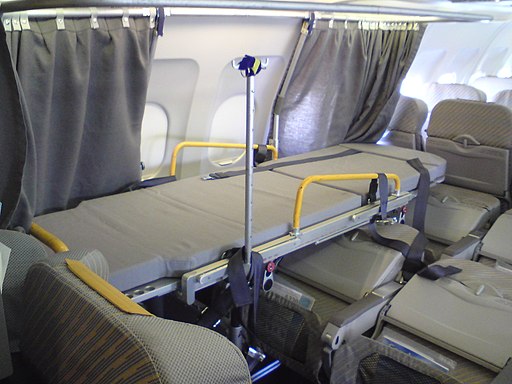Commercial airline stretchers are fitted in the last rows of seats of a regularly scheduled commercial flight. The patient is separated by a curtain from other passengers for privacy, and the accompanying medical team travels with them to monitor their condition throughout the journey.
This type of transport is cost-effective and can save patients and families tens of thousands of dollars over an air ambulance. It also allows for a direct, non-stop route.
Stability
Airline stretcher flights are ideal for patients requiring medical transport but who do not require the full services of an emergency medical aircraft. This service allows patients to travel in a first or business-class seat with a nurse escort but cannot sit up or stand during the flight.
The airline will remove a block of seats from the aircraft and install an FAA-approved airplane stretcher, allowing the patient to remain lying during the flight. The escort will sit beside the patient to monitor their condition throughout the journey.
This international non-emergency air ambulance service is very affordable, usually costing half what it would book an air ambulance jet for the same flight length. It is also quicker than traveling by land ambulance, as flights don’t have to stop for refueling. Traveling with family members on these commercial airlines is also possible, which can’t be done with dedicated air ambulance jets.
Reliability
The reliability of commercial airline stretchers depends on the reputation and track record of the company. Look for reviews and testimonials from past customers to determine if the service is reliable. You should also look into how long the company has been in business and what type of medical transports they have performed over the years.
Airline stretcher repatriations are often more affordable than transferring patients on a private air ambulance jet, especially for longer flights. They can also provide quicker arrivals without requiring multiple layovers for fuel refills.
The commercial flight team will fit the stretcher over a block of seats in the airplane’s rear and install a temporary screen to give patients privacy. They will then connect the patient to monitoring equipment and medicines. Then they will manage your patient’s care throughout the flight until landing at the destination airport. They will then transfer them to an ambulance to get them to the hospital.
Safety
International commercial flight stretchers are ideal for patients who cannot sit through a long flight in traditional airline seating. They can rest comfortably through the trip, and a medical team travels to monitor their condition and provide care. This cost-effective option for repatriation or medical evacuation saves families tens of thousands of dollars over a chartered jet service.
A stretcher of this type has legs that are releasably locked into a raised position for supporting the stretcher or folding down into a stored position. When the legs are lifted, they anchor to the same channels that hold the seats in place on the airplane.
The legs also include restraining means such as seat belt-type straps that go across the chest and waist of the patient. This prevents the stretcher from moving during turbulence on the plane during take-off and landing. Preferably the leg anchoring system is also adapted to engage with the seat anchoring system on the airplane floor.
Comfort
Commercial airline stretcher service is a cost-effective alternative to air ambulance transport. It allows patients to fly in first or business class and receive advanced medical care for the duration of their flight.
In addition, the flight is much less stressful for patients since there’s little jarring movement and noise from propellers or other aircraft. This can be especially important for patients who have difficulty sitting for extended periods or suffer from spinal injuries and other back problems.
Another advantage of an air ambulance stretcher is that patients can travel on a regularly scheduled airline flight with their family members. This bed-to-bed service provides a medical escort from when you leave the hospital or medical center until you arrive at your destination and are transferred to your new care team.
Featured Florian Waßmann, CC BY 3.0, via Wikimedia Commons
